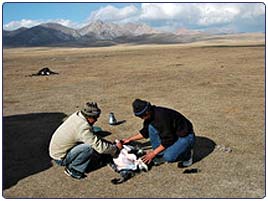Archaeologists Uncover 2500-year-old Civilization in Russia
By | Jan 04, 2008

Moscow, Dec 28 (ANI): Archaeologists have discovered the remains of a 2500-year-old advanced civilization at the bottom of Lake Issyk Kul in the Kyrgyz mountains in Russia.
According to a report in RIA Novosti, the team consisted of Kyrgyz historians, led by Vladimir Ploskikh, vice president of the Kyrgyz Academy of Sciences, and other Russian colleagues, like historian Svetlana Lukashova.
The expedition resulted in sensational finds, including the discovery of major settlements, presently buried underwater.
The data and artefacts obtained, which are currently under study, apply the finishing touches to the many years of exploration in the lake, made by seven previous expeditions.
The discovery consisted of formidable walls, some stretching for 500 meters-traces of a large city with an area of several square kilometers.
Other findings included Scythian burial mounds, eroded by waves over the centuries, and numerous well preserved artifacts-bronze battleaxes, arrowheads, self-sharpening daggers, objects discarded by smiths, casting molds, and a faceted gold bar, which was a monetary unit of the time.
All these discoveries suggest that the ancient city was a metropolis in its time.
Some artifacts are in fact so stunning that they point towards an advanced civilization.
For example, a 2,500 year-old ritual bronze cauldron was found on the bottom of the lake. The subtlety of its craftsmanship is amazing. Such excellent quality of joining details together can only be obtained presently by metalwork in an inert gas.
Also of superb workmanship are bronze mirrors, festive horse harnesses and many other objects. Articles identified as the world’s oldest extant coins were also found underwater-gold wire rings used as small change and a large hexahedral goldpiece.
Side by side with the settlements are remnants of ritual complexes of times immemorial, dwellings and household outbuildings.
According to the researchers, the findings lead to the speculation that the local people at that time had a socio-economic system hitherto unknown to historians. As a blending of nomadic and settled life, it either gradually evolved into something different or-more likely-was destroyed by one of the many local floods.
Lake Issyk Kul has played a tremendous role since the inception of human history due to its geographic location at the crossing of Indo-Aryan and other nomadic routes. Archeologists found traces of many religions here-Zoroastrianism, Buddhism, Judaism, Christianity and Islam. (ANI)















